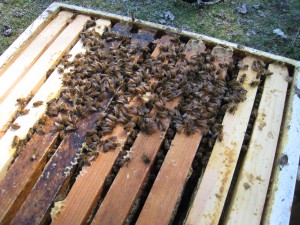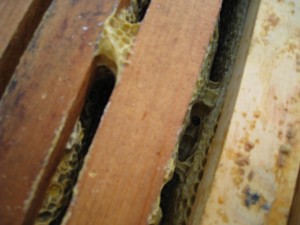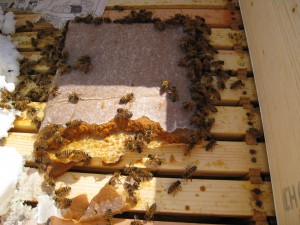
Being my first Winter, I can only read about what to expect (and ask some of the experienced folks in my area.) One of the things that I keep reading about is swarm prevention in these early months before the main nectar flow. One strategy (that I am going to implement) is to ‘reverse your deeps’. Effectively, the bees work there way up into the top deep (eating honey as they go) as they prep for the coming Spring. Once they get to the top, they are more inclined to go into Swarm Prep mode, as it appears that they are out of space.
To combat this, you supposedly (I have not done it yet – this is my first Winter) swap the bottom and top deep’s (thus pushing the girls back to the bottom with a lot of empty, drawn comb above them.) They suddenly decide that they cannot waste energy going into Swarm Prep until they fill out that comb above (the number 1 driver for a bee is to live through the coming Winter – build stores, the number two driver is to propagate, or swarm.)
Well, I went into my hives yesterday (temps got into the upper-50’s) and both clusters were still in the lower deeps. I actually took the top deep off of the weaker hive (Hive 1), as I could see that they were not in the upper deep. The entire cluster was still in the same spot that they were congregating in November – up at the front of the hive. I have heard experienced beekeepers say that a good cluster is about the size of a basketball. I’m not sure these were that big, but they were dang close (see Pic : Is this a lot of bees?).
But, back to the original point, they had not taken a single step into the upper deep (in fact, neither hive had.) They were no where close to needing a ‘reversal’. I am guessing this is perfectly normal, but I had expected to see some movement up. It’s actually great news, as both hives have 8+ frames full of honey (all above them). This should get them through the Winter (assuming they have the occasional warm stretch to reach it), although I can only attest to honey storage. So, hopefully my pollen patties will take care of the rest.

On a side note, this second picture shows the problems with having frames that are not pushed together. As mentioned in a previous post last Summer, I made a rookie error when I got my bees. Basically, I brought a Deep, full of foundation, to Tom Fifer to pick up my Nuc. He gave me 5 of his frames (full of bees, honey, brood and pollen – and of course the grand lady of a queen) for 5 of my empty frames. We closed the hive back up and left it for several hours before I came back that evening to put some hardware cloth over the entrance and transport them back to my home. Once at my home, I took the hardware cloth off.
This all worked great, but I missed the next step, which was crucial. I left them alone for two weeks before I started weekly check-ins (Hive Investigations), where I would pull the frames out and look at the busy ladies doing their stuff. The problem was that, during the transportation, the frames had become a bit disoriented and unevenly spaced. Although I only waited two weeks to open them up, that was enough time for them to build partial comb (I think they call it burr comb) all over the place, between the frames. It was a mess and I did not want to mess with these new bees by cutting it all out. Needless to say, this situation needs resolution, which I plan to do when I do the reversal! So, the reversal is both for the bees (anti-swarm) and the beekeeper (clean up a mess he is responsible for)!

This next picture shows the bees from my strong hive (Hive 2), gorging on the pollen patty that I dropped in here last week. Of note, the weak hive did not appear to have touched the pollen patty that I left for them, but I am not sure that they have ever taken to the pollen substitute (they seem to like to throw it out of the hive, actually…) These gals, however, are going to town on this pollen substitute. There were a lot more bees in the upper deep as well, although most of the honey remains untouched (a good sign, I hope.) This hive was the most active today (in fact, this is the first time that they have been the most active.) Bees were all over the place and I actually saw some of them bringing in pollen (usually, Hive 1 is the only one that I actually see this activity in.) It’s good to see this life, although I wasn’t overly worried. It should be noted that these gals came out of the inner cover like a whirlwind when I took the top off. One of them did get a bit grumpy and would have stung me if she could have found purchase. But, I can’t blame her. It’s cold, no nectar is available and here is some joker in white poking around in my honey stores!
All in all, this was a good inspection. The Bees are alive. Honey stores appear to be good. The beekeeper was not stung=) In truth, it is an interesting lesson when reviewing all of the hand wringing I have been doing in previous journal entries. It’s been a tough Winter (or so I think). It will be interesting to see what other Beekeepers are seeing as a comparison. Hopefully, all are fairing as well or better.
